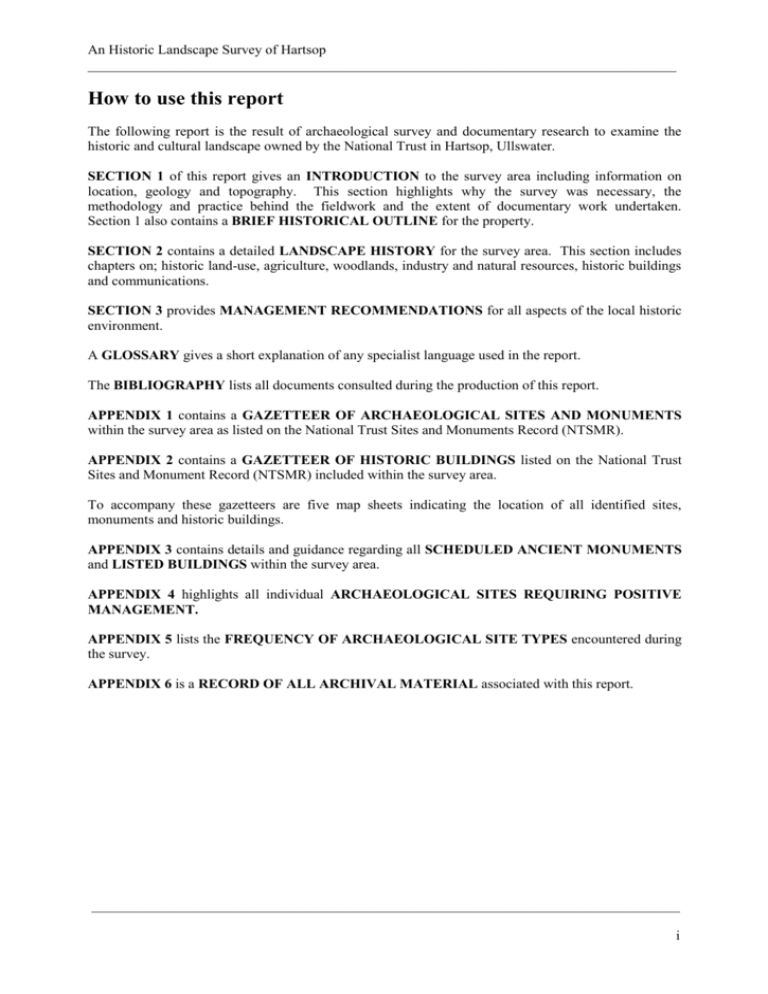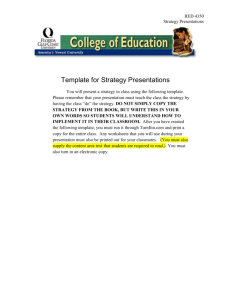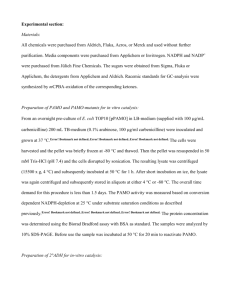Hartsop Historical Landscape Survey
advertisement

An Historic Landscape Survey of Hartsop ___________________________________________________________________________________ How to use this report The following report is the result of archaeological survey and documentary research to examine the historic and cultural landscape owned by the National Trust in Hartsop, Ullswater. SECTION 1 of this report gives an INTRODUCTION to the survey area including information on location, geology and topography. This section highlights why the survey was necessary, the methodology and practice behind the fieldwork and the extent of documentary work undertaken. Section 1 also contains a BRIEF HISTORICAL OUTLINE for the property. SECTION 2 contains a detailed LANDSCAPE HISTORY for the survey area. This section includes chapters on; historic land-use, agriculture, woodlands, industry and natural resources, historic buildings and communications. SECTION 3 provides MANAGEMENT RECOMMENDATIONS for all aspects of the local historic environment. A GLOSSARY gives a short explanation of any specialist language used in the report. The BIBLIOGRAPHY lists all documents consulted during the production of this report. APPENDIX 1 contains a GAZETTEER OF ARCHAEOLOGICAL SITES AND MONUMENTS within the survey area as listed on the National Trust Sites and Monuments Record (NTSMR). APPENDIX 2 contains a GAZETTEER OF HISTORIC BUILDINGS listed on the National Trust Sites and Monument Record (NTSMR) included within the survey area. To accompany these gazetteers are five map sheets indicating the location of all identified sites, monuments and historic buildings. APPENDIX 3 contains details and guidance regarding all SCHEDULED ANCIENT MONUMENTS and LISTED BUILDINGS within the survey area. APPENDIX 4 highlights all individual ARCHAEOLOGICAL SITES REQUIRING POSITIVE MANAGEMENT. APPENDIX 5 lists the FREQUENCY OF ARCHAEOLOGICAL SITE TYPES encountered during the survey. APPENDIX 6 is a RECORD OF ALL ARCHIVAL MATERIAL associated with this report. ___________________________________________________________________________________ i An Historic Landscape Survey of Hartsop ___________________________________________________________________________________ Acknowledgements A debt of thanks is owed to all those who gave up their time freely to assist in the compilation of this report. Most notably Warren Allison, Richard Clark, Stuart Cresswell, Andy Lowe and Angus Winchester who all contributed valuable information. Thanks also to the staff at the Record Offices at Carlisle and Kendal. The archive of William Shaw was viewed with the kind permission of Jayne Firth. Thanks also to Judith Derbyshire, Steve Dowsen, Robert Maxwell, Mark Newman and Ken Ratcliffe at the National Trust in thinking through many of the ideas presented in this report. Final thanks should go to Mr. R Taylforth at Side Farm and Beckstones, Mr. J Hodgson at Hartsop Hall Farm and Mr A and E Wear at How Green Farm for allowing me to undertake survey work while the valley was still in the shadow of foot and mouth disease. ___________________________________________________________________________________ ii An Historic Landscape Survey of Hartsop ___________________________________________________________________________________ TABLE OF CONTENTS SECTION 1 – INTRODUCTION ........................................................................................................................... 6 1.1. INTRODUCTION ............................................................................................................................................... 6 1.1.1. Location of the survey area ..................................................................................................................... 6 1.1.2. Geology, topography and hydrology ....................................................................................................... 7 1.1.3. Background and methodology to the survey ............................................................................................ 8 1.2. BRIEF HISTORICAL OUTLINE ........................................................................................................................ 9 SECTION 2 – A LANDSCAPE HISTORY ...........................................ERROR! BOOKMARK NOT DEFINED. 2.1. EARLY ACTIVITY....................................................................................... ERROR! BOOKMARK NOT DEFINED. 2.1.1. Prehistoric occupation ............................................................................. Error! Bookmark not defined. 2.1.2. The Romano-British period ...................................................................... Error! Bookmark not defined. 2.2. THE POST-ROMAN AND EARLY-MEDIEVAL PERIODS ............................. ERROR! BOOKMARK NOT DEFINED. 2.2.1. The Pre-Conquest landscape .................................................................... Error! Bookmark not defined. 2.3. THE MEDIEVAL LANDSCAPE - 1092 TO 1600 ........................................... ERROR! BOOKMARK NOT DEFINED. 2.3.1. Early enclosure and settlement 1092 - 1300 ............................................ Error! Bookmark not defined. 2.3.2. Later enclosure and settlement 1300 - 1600 ............................................. Error! Bookmark not defined. 2.3.3. The boundaries of the Manor of Hartsop ................................................. Error! Bookmark not defined. 2.4. THE POST-MEDIEVAL PERIOD - 1600 TO 1800 ........................................ ERROR! BOOKMARK NOT DEFINED. 2.4.1. Society in the Post-Medieval period 1600 to 1800 ................................... Error! Bookmark not defined. 2.4.2. The agricultural landscape 1600 to 1800 ................................................. Error! Bookmark not defined. 2.4.3. Early tourists in Hartsop .......................................................................... Error! Bookmark not defined. 2.5. THE NINETEENTH CENTURY..................................................................... ERROR! BOOKMARK NOT DEFINED. 2.5.1 Landscape and society ............................................................................... Error! Bookmark not defined. 2.5.2. Later tourists in Hartsop .......................................................................... Error! Bookmark not defined. 2.6. THE TWENTIETH CENTURY ...................................................................... ERROR! BOOKMARK NOT DEFINED. 2.7. WOODLANDS AND WOODLAND MANAGEMENT ....................................... ERROR! BOOKMARK NOT DEFINED. 2.7.1. Enclosed woodlands ................................................................................. Error! Bookmark not defined. 2.7.2. Conifers and plantation woodlands .......................................................... Error! Bookmark not defined. 2.7.3. Pollards and wood pasture ....................................................................... Error! Bookmark not defined. 2.7.4. Individual trees ......................................................................................... Error! Bookmark not defined. 2.8. THE BUILT ENVIRONMENT ....................................................................... ERROR! BOOKMARK NOT DEFINED. 2.8.1. Beckstones Farm ...................................................................................... Error! Bookmark not defined. 2.8.2. Hartsop Hall Farm ................................................................................... Error! Bookmark not defined. 2.8.3. Howe Green Farm .................................................................................... Error! Bookmark not defined. 2.9. INDUSTRIES AND NATURAL RESOURCES .................................................. ERROR! BOOKMARK NOT DEFINED. 2.9.1. Charcoal burning ..................................................................................... Error! Bookmark not defined. 2.9.2. Bark peeling.............................................................................................. Error! Bookmark not defined. 2.9.3. Potash making .......................................................................................... Error! Bookmark not defined. 2.9.4. Quarries and stone extraction .................................................................. Error! Bookmark not defined. 2.9.5. Caudale Moor slate quarry ...................................................................... Error! Bookmark not defined. 2.9.6. Hartsop Hall lead mine ............................................................................ Error! Bookmark not defined. 2.9.7. Low Hartsop or Myers Head lead mine ................................................... Error! Bookmark not defined. 2.9.8. Dodd End lead mine ................................................................................. Error! Bookmark not defined. 2.9.9. Kirkstone Pass lead mine ......................................................................... Error! Bookmark not defined. 2.9.10. Caiston Glen lead mine .......................................................................... Error! Bookmark not defined. 2.9.11. Hogget Gill lead smelter......................................................................... Error! Bookmark not defined. 2.9.12. The iron bloomery .................................................................................. Error! Bookmark not defined. 2.9.13. Hartsop corn mill ................................................................................... Error! Bookmark not defined. 2.9.14. Peat......................................................................................................... Error! Bookmark not defined. 2.9.15. Bracken ................................................................................................... Error! Bookmark not defined. 2.10. EVIDENCE OF AGRICULTURE .................................................................. ERROR! BOOKMARK NOT DEFINED. 2.10.1. Arable agriculture .................................................................................. Error! Bookmark not defined. 2.10.2. Pastoral agriculture ............................................................................... Error! Bookmark not defined. 2.11. WATER MANAGEMENT AND DRAINAGE .................................................. ERROR! BOOKMARK NOT DEFINED. 2.12. COMMUNICATION.................................................................................... ERROR! BOOKMARK NOT DEFINED. 2.12.1. Routeways ............................................................................................... Error! Bookmark not defined. ___________________________________________________________________________________ iii An Historic Landscape Survey of Hartsop ___________________________________________________________________________________ 2.12.2. Bridges and clapperbridges .................................................................... Error! Bookmark not defined. 2.13. MISCELLANEOUS AND UNCLASSIFIED SITES .......................................... ERROR! BOOKMARK NOT DEFINED. SECTION 3 – MANAGEMENT RECOMMENDATIONS .................ERROR! BOOKMARK NOT DEFINED. 3.1. MANAGEMENT RECOMMENDATIONS FOR INDIVIDUAL SITES .................. ERROR! BOOKMARK NOT DEFINED. 3.2. SETTLEMENT AND BUILDING RECOMMENDATIONS .................................. ERROR! BOOKMARK NOT DEFINED. 3.2.1.General Recommendations ........................................................................ Error! Bookmark not defined. 3.3. BOUNDARY RECOMMENDATIONS .............................................................. ERROR! BOOKMARK NOT DEFINED. 3.3.1. Walls and wall furniture ........................................................................... Error! Bookmark not defined. 3.3.2. Hedges and hedgebanks ........................................................................... Error! Bookmark not defined. 3.3.3. Railings and fencing ................................................................................. Error! Bookmark not defined. 3.4. WOODLAND AND TREE PLANTING RECOMMENDATIONS .......................... ERROR! BOOKMARK NOT DEFINED. 3.4.1. General recommendations ........................................................................ Error! Bookmark not defined. 3.4.2. Recommendations for particular woodlands ............................................ Error! Bookmark not defined. 3.4.3. Plantation woodlands ............................................................................... Error! Bookmark not defined. 3.4.4. Pollards .................................................................................................... Error! Bookmark not defined. 3.4.5. Individual trees ......................................................................................... Error! Bookmark not defined. 3.5. RECOMMENDATIONS FOR INDUSTRIAL MONUMENTS .............................. ERROR! BOOKMARK NOT DEFINED. 3.5.1. Management of industrial sites and buildings .......................................... Error! Bookmark not defined. 3.6. LAND USE RECOMMENDATIONS ................................................................ ERROR! BOOKMARK NOT DEFINED. 3.6.1. Agriculture................................................................................................ Error! Bookmark not defined. 3.7. WATER MANAGEMENT AND DRAINAGE .................................................... ERROR! BOOKMARK NOT DEFINED. 3.7.1. General recommendations ........................................................................ Error! Bookmark not defined. 3.8. COMMUNICATIONS .................................................................................... ERROR! BOOKMARK NOT DEFINED. 3.8.1. Walkers cairns .......................................................................................... Error! Bookmark not defined. 3.8.2. Footpath repairs ....................................................................................... Error! Bookmark not defined. 3.9. PRIORITIES FOR FUTURE RESEARCH AND INTERPRETATION ................... ERROR! BOOKMARK NOT DEFINED. 4.0. GLOSSARY .......................................................................................ERROR! BOOKMARK NOT DEFINED. 5.0. BIBLIOGRAPHY .............................................................................ERROR! BOOKMARK NOT DEFINED. APPENDIX 1 - GAZETTEER OF ARCHAEOLOGICAL SITES AND MONUMENTSERROR! BOOKMARK NOT DEFINE APPENDIX 2 - GAZETTEER OF HISTORIC BUILDINGS .............ERROR! BOOKMARK NOT DEFINED. APPENDIX 3 –SCHEDULED ANCIENT MONUMENTS AND LISTED BUILDINGSERROR! BOOKMARK NOT DEFINE APPENDIX 4 - ARCHAEOLOGICAL FEATURES REQUIRING POSITIVE MANAGEMENTERROR! BOOKMARK NOT APPENDIX 5 - FREQUENCY OF SITE TYPES .................................ERROR! BOOKMARK NOT DEFINED. APPENDIX 6 - LIST OF ARCHIVE MATERIAL PRODUCED BY THIS REPORTERROR! BOOKMARK NOT DEFINED. ___________________________________________________________________________________ iv An Historic Landscape Survey of Hartsop ___________________________________________________________________________________ List of Figures Figure 1 Figure 2 Figure 3 Figure 4 Figure 5 Figure 6 Figure 7 Figure 8 Figure 9 Figure 10 Figure 11 Figure 12 Figure 13 Figure 14 Figure 15 Figure 16 Figure 17 Figure 18 Boundary of the survey area Plan of the cup marks at Beckstones Farm, from Beckensall, S. 2002 Plan of the Romano-British farmstead near Hartsop Hall Farm, from RCHME. 1936 The boundaries of the Manor of Hartsop The development of early-enclosure in Hartsop Depiction of Brother Field, Low Hartsop Field and (High) Hartsop Field in 1764 (D/Lons/L/Plans) The redrawn Enclosure Award map for Overdale in Hartsop, 1861-1865 (WQR/I/74) The location of the grazing pastures in High and Low Hartsop The later agricultural landscape of Hartsop Plan of woodland archaeology recorded in the Hartsop demesne Survey of land at Beckstones and Dubhow (D/Lons/L5/13) The 1863 First Edition 6 inch Ordnance Survey map showing Brothers Water The 1899 Second Edition 6 inch Ordnance Survey map showing Brothers Water The 1863 First Edition 25 inch Ordnance Survey map showing part of Hayeswater Gill The 1915 Second Edition 25 inch Ordnance Survey map showing part of Hayeswater Gill Walls in need of repair on Beckstones Farm Walls in need of repair on Hartsop Hall Farm. Walls in need of repair on Howe Green Farm Page 2 7 9 17 after 17 20 26 27 after 29 41 53 57 57 58 58 65 66 67 List of Photographs Photograph 1 Photograph 2 Photograph 3 Photograph 4 Photograph 5 Photograph 6 Photograph 7 Photograph 8 Photograph 9 Photograph 10 The survey area seen from the Kirkstone Pass The panel of prehistoric cup marks at Beckstones Farm View of the valley head enclosure in Dovedale View of intakes along Hayeswater Gill The valley side enclosure known as New Forest The landscape within the survey area today A view of Hartsop Hall Farm The wheel pit and stone piers at Low Hartsop lead mine View over Brother Field and High Hartsop Field A robbed wall and walkers cairn on the high fell Page 1 7 14 16 21 30 31 47 52 74 The copyright for all photography in this report belongs to the National Trust, except for Photograph 4, © Ronald Mitchell. ___________________________________________________________________________________ v An Historic Landscape Survey of Hartsop ___________________________________________________________________________ ________ Section 1 – Introduction 1.1. Introduction The following report is the result of archaeological survey and documentary research to examine the historic and cultural landscape around Hartsop in the southern part of the Ullswater valley. It represents one of a series of such surveys of properties owned by the National Trust in the Lake District that also includes; Great Langdale, Watendlath and Ashness, Hawkshead and Claife, Wasdale Head and Coniston. The purpose of historic landscape survey is threefold; the construction of a historic and cultural narrative for the local landscape, the identification of all sites and monuments of archaeological or historic importance within the survey area and the production of management recommendations for both individual sites and landscapes. 1.1.1. Location of the survey area The survey area includes all valley bottom and fellside land from the Kirkstone Pass as far north as Beckstones Farm just south of Patterdale. Brothers Water is situated close to the heart of the survey area (centred at NY 40251275), the area surveyed is contained on the five Ordnance Survey 1:10000 sheets NY 30 NE, NY 31 SE, NY 40 NW, NY 41 SW and NY 41 NW. Photograph 1 – The survey area seen from the Kirkstone Pass The survey area comprises some 3640 acres. Of this total around 3500 acres are currently maintained as pasture or meadow within the tenancies of three farms; Beckstones, Hartsop ___________________________________________________________________________ ________ 6 An Historic Landscape Survey of Hartsop ___________________________________________________________________________ ________ Hall and Howe Green. The only significant area of woodland within the survey area is Low Wood, comprising some 172 acres to the west of Brothers Water. The boundary of the survey area is outlined in red in figure 1. The survey boundary is a product of the present land holding of the National Trust and is not designed to reflect any earlier pattern of land ownership or ancient boundary. Figure 1 – Boundary of the survey area 1.1.2. Geology, topography and hydrology The survey area is located within the broad band of Borrowdale volcanic rock laid down to form the rugged heart of the Lake District some 450 million years ago. The altitude within the survey area ranges from 150m OD on the valley bottom close to Brothers Water, to 822m ___________________________________________________________________________ ________ 7 An Historic Landscape Survey of Hartsop ___________________________________________________________________________ ________ OD on the top of Hart Crag. The crags are most well developed in the south-western part of the survey area, especially around Dove Crag. The glacial corries are not particularly well formed in the area, although Caudale Head is a fine example. Soils within the lower parts of the survey area are mostly poorly drained, podsolised brown earths. These soils are characterised by a brown mineral upper layer and a pale, acidic lower part from which minerals, nutrients and so on have been leached away by water. On the higher ground the soils are characterised by gleyed soils with impeded drainage and a peaty top layer; some deeper accumulations of peat occur locally. The survey area contains three bodies of water, two of which are owned by the National Trust. The first is Brothers Water, a shallow lake that occupies the valley floor to west of Hartsop. The lake was formed after the valley floor was dammed by outwashed morainic material close at the point where Hayeswater Gill reaches the valley bottom. The second is Angle Tarn, a high level tarn, sitting in a hollow carved by ice and replenished by water falling within its catchment area. The third body of water, Hayeswater, is owned by United Utilities, although the shoreline does belong to the National Trust. Hayeswater is located in a small glaciated valley between High Street and Grey Crag to the east of Hartsop. Hayeswater is hemmed in by a series of moranic mounds formed through recessional retreat along its north-western edge, making it particularly suited for use as a reservoir. The lake was purchased from James William Lowther in 1908 and a dam erected soon afterwards. 1.1.3. Background and methodology to the survey Fieldwork for this report was carried out by Jamie Lund, the National Trust regional archaeologist between November 2001 and March 2002. Prior to fieldwork the existing National Trust Sites and Monuments Record (NTSMR) was consulted to identify any known archaeological sites within the survey area. A search was also made of the SMR maintained by the Lake District National Park Authority. Details of all archaeological sites identified during field survey were recorded on pro-forma sheets and their positions recorded onto a 1:2500 scale map wherever coverage allowed, otherwise using enlargements taken from 1:10000 scale maps. A complete list of all sites and monuments recorded appears in APPENDIX 2. Field survey also included an examination of all standing and relict boundaries within the survey area. Details of all boundaries, including the position of all gates, stiles and other wall furniture, were recorded at a scale of 1:2500 or 1:10000 and a description recorded on a proforma. This information, along with any useful historic documents, provides the basis for the interpretation of the sequence of enclosure outlined in the report. A search of the relevant historic documents and archives relating to the survey area was also undertaken at the Cumbria Record Offices at Kendal and Carlisle. A complete list of all documents referred to in the text appears in the BIBLIOGRAPHY. A list of the associated survey archive, including hand-written survey information, photographs and transcriptions of archive material, appears in APPENDIX 6. ___________________________________________________________________________ ________ 8 An Historic Landscape Survey of Hartsop ___________________________________________________________________________ ________ 1.2. Brief Historical Outline The earliest archaeological evidence for human activity within the survey area is the panel of prehistoric rock art recently discovered near Beckstones Farm. These pecked ‘cup marks’ are believed to have been made during the Neolithic period some 5000 years ago. There is no evidence to suggest that there existed any permanent settlement in the area around Hartsop during the Neolithic, nor during the later-prehistoric period between 3000 BC and 43AD. The only evidence for activity during this period is the possible prehistoric burial mound situated close to the confluence of Kirkstone Beck and Dovedale Beck. Adjacent to the possible burial mound is a Romano-British farmstead thought to have been occupied sometime around the second century AD. Two Roman roads pass through the survey area. The first runs across High Street along the eastern edge of the survey area, the second descends the Kirkstone Pass and continues through the valley to the west of Brothers Water towards Patterdale. In the seventh century the Lake District valleys were absorbed into the Anglian kingdom of Northumbria. The lack of archaeological evidence from this period makes any detailed understanding of life and society in the region difficult. The name Hartsop has Old English origins and means ‘valley of the deer’. This may be an indication that the valley was settled or regularly visited sometime between the seventh and ninth centuries. While Northumbrian rule may have encouraged an influx of settlers into some parts of the Lake District, many areas are thought to have remained densely wooded until the tenth century and the arrival of Norse speaking peoples to the Cumbrian coast. The Norse settlers appear to have moved inland, even as far as the central fells, clearing woodland and establishing small farming communities. The Norman Conquest after 1066 resulted in great change to the pattern of settlement and society across the medieval landscape of Northern England, although for part of the latereleventh century the northern Lake District remained part of the kingdom of Strathclyde. As a result of the Norman victory at Carlisle in 1092 large parts of unoccupied land in what is now Cumbria was allotted to Norman Lords, many of whom settled with their retinues to occupy these areas. There is no surviving documentary evidence to piece together the early history of the Manor of Hartsop and as a result our understanding of the immediate postconquest landscape is based on field evidence and information extrapolated from other areas. In many Lake District valleys the rise in population during the twelfth and thirteenth centuries encouraged the development of a simple system of communal farming based around the enclosure of meadow and arable lands on the valley bottom within a single wall or ‘ringgarth’. The ring-garth not only prevented stock from trampling crops growing on the valley bottom, but also acted as a political boundary between the tenanted agricultural land and the unenclosed fell that belonged to the Lord of the Manor. A form of ring-garth exists in Hartsop. This boundary encloses land on the valley bottom to the north and south of Brothers Water, as well as in Dovedale. The area known as Dovedale, along with all land within the Manor of Hartsop to the west of Caiston Beck and Kirkstone Beck was retained by the Lord as in-hand or ‘demesne’ land. During the early post-conquest period the demesne may have functioned as a hunting ground or ‘chase’. Some time after the enclosure of the valley bottom land, a wall was set up to enclose the valley head in Dovedale. This boundary is believed to have enclosed a large cattle pasture and suggests that the demesne may have been managed as a vaccary or cattle ranch. The existence of large numbers of cattle in the valley is highlighted in a document of ___________________________________________________________________________ ________ 9 An Historic Landscape Survey of Hartsop ___________________________________________________________________________ ________ 1255 that records a complaint against the Lord of the Manor of Hartsop for allowing his cattle to trespass on the neighbouring ‘forest’ land. The demesne also contained an early hall. This hall was presumably occupied by the Lord of the Manor from the twelfth or early-thirteenth century given the status of Hartsop as a separate medieval manor. The early division of land within the Manor of Hartsop between demesne and free forest encouraged the development of two very different patterns of settlement and enclosure. The eastern half of the Manor of Hartsop was settled and farmed by tenants in the early postconquest period. Two separate settlements developed alongside the two common fields north and south of Brothers Water. Low Hartsop developed in a side valley to the north-east of Brothers Water. To the south the string of tenements appeared alongside the ring-garth at the foot of the Kirkstone Pass and became known as High Hartsop. Outside the ring-garth additional land began to be enclosed within small irregular shaped fields known as ‘intakes’. Around Low Hartsop early intaking concentrated on the low valley sides to the north and south of the village, as well as to the east along the sides of Hayeswater Gill. At High Hartsop intaking was restricted to the land adjacent to the ring-garth by the steep, scree covered fellsides to the east. Some intakes may have been cleared of stone and cultivated, while others were managed as additional cattle pastures. There is no sign of early intaking within the demesne. The area appears to have witnessed little change until a new hall was established sometime in the fourteenth century. It is likely that the core of the new hall was set up before the de Lowther family took possession of the Manor of Hartsop in 1463 as part of a marriage dowry from the de Lancaster family. The de Lancaster family had possession of Hartsop since at least the thirteenth century. The Manor of Hartsop passed between the de Lowther and de Lancaster families until 1638, after which time it remained part of the Lowther estate until the twentieth century. It is quite likely that the hall and demesne at Hartsop were both abandoned by the de Lowthers and rented out to a tenant farmer sometime in the early-seventeenth century. There are certainly no documentary references to the Lord being in residence after 1600. It was around this time that the hall was extended for use as a farmhouse and a new barn set up nearby. Some enclosure of land within the demesne may have taken place around this time as a consequence of changes in the pattern of farming and land-use. The enclosed valley head in Dovedale may have been sub-divided around this time and parcels of wood pasture enclosed on the lower slopes of Wood Side. It is possible that further intaking took place on tenanted land around this time, although documentary evidence is lacking. The earliest surviving rental for the Manor of Hartsop dates from 1574, this document records the existence of around thirty separate tenements. During this time the picture of agriculture in Hartsop is one in which the valley bottom is almost entirely maintained as meadow with subsistence crops of oats and barley growing in the enclosed intakes situated on the dryer and warmer south-facing slopes. Farming at this time was increasingly dominated by sheep rearing to supply the burgeoning wool trade. The earliest reference to the communal management and ‘stinting’ on the fells appears in 1640, although the system of management is likely to have been long established by this time. The first private enclosure of land on the valley bottom took place in the late-seventeenth or early-eighteenth century. A number of fences are shown in Brother Field to the north of Brothers Water in the survey of the Manor of Hartsop from 1764. Despite this the majority of land on the valley bottom continued to be managed as common. Some fell walls had also been established prior to 1764. The cow pasture known as ‘Hull and Side’ north of Low ___________________________________________________________________________ ________ 10 An Historic Landscape Survey of Hartsop ___________________________________________________________________________ ________ Hartsop was enclosed so that it could be stinted separately from the surrounding fell. During the eighteenth century more intakes appeared on the higher fellsides, often enclosing quite marginal areas that required extensive improvement. For a short period in the later part of the eighteenth century and early-nineteenth century upland farms enjoyed a period of prosperity as a result of the sharp rise in food prices as a consequence of the French and Napoleonic Wars. Despite this the number of farms continued to decline. By 1800 there were just seventeen farms in the Manor of Hartsop, the number fell to thirteen in 1831 and just seven in 1894. As the number of farms declined land was often purchased by neighbouring farms allowing them to expand and increase output. Redundant farmhouses and buildings were found a new use or let as cottages to farm labourers or nonagricultural workers or simply abandoned. This depopulation and amalgamation of farm land paved the way for the enclosure of common land in the second half of the nineteenth century. Many forms of industry are represented in and around Hartsop, with the demesne being more heavily exploited for industry than the tenanted lands. Of greatest significance are the two complex multi-period lead mining sites known as Hartsop Hall and Myers Head. Another three smaller, short-lived lead mines also exist within the survey area. The remains of a lead smelter and white coal kiln set up in the late-seventeenth century on Hogget Gill still survive. An extensive collection of buildings and workings associated with the Caudale Moor slate mine exist high above the Kirkstone Pass road. There are in addition many locally important industrial sites including over thirty charcoal burning platforms, a potash pit, a corn mill and kiln and an early iron bloomery. There has been relatively little landscape change within the survey area during the twentieth century. The pattern of enclosure has changed little in the last hundred years. The only new boundaries to be erected are fences alongside collapsed walls and field drains. The twentieth century has witnessed a continued decline in the number of separate farms within the survey area. With this has come a decline in the rural labourforce, with fewer farms meaning more work for those who remain. As a consequence many walls, buildings and other features in the landscape that are no longer in agricultural use have fallen into decay. In 1947 Hartsop Hall Farm became the first farm in the country to be handed over to the National Trust in lieu of Death Duties. Howe Green Farm was sold to the Lake District Farm Estates in 1956 who passed it onto the National Trust in 1976. Caudalebeck Farm was purchased in 1965 and soon after amalgamated with Hartsop Hall Farm. Beckstones Farm, situated just outside the former Manor of Hartsop, was purchased in 1986. The most recent acquisition was Grove Farm purchased in 1992 and amalgamated with Howe Green Farm in 2000. ___________________________________________________________________________ ________ 11 An Historic Landscape Survey of Hartsop ___________________________________________________________________________ ________ ___________________________________________________________________________ ________ 12








